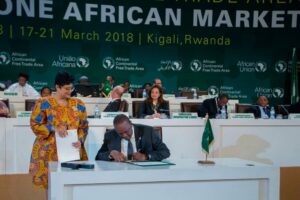
East African Nations’ Trade Refuge in the Pan-African Trade and Investment Agency
Linking Financial Resources to Investment
Trade between Kenya and Tanzania, the two most significant markets within the East African community, has often been characterized by sabotage and trade wars that derail business activity and progress for their citizens. This signifies the need for lasting solutions and interventions in East Africa to solve recurring trade challenges. The establishment of the African Continental Free Trade Area (AfCFTA) agreement, a framework that seeks to enhance regional integration and create a common market for Africa, is a wake-up call for the two nations to collaborate towards a common goal. A crucial aspect of the AfCFTA is the establishment of the investment protocol under which a Pan-African Trade and Investment Agency has been proposed.
The agency is tasked with mobilizing financial resources for investment protocol agencies, encouraging business development, and providing technical assistance for investment promotion. This is, therefore, an opportune time for Kenya and Tanzania to leverage the trade and investment agency under the AfCFTA and coordination under the East African Community to drive prosperity within the region. Thus, fast-tracking the establishment and trading under the AfCFTA investment protocol is a priority for nations such as Kenya and Tanzania to boost trade and coordination in investment to enhance economic growth.
Conceptualizing Progress under the Pan-African Trade and Investment Agency
The Pan-African Trade and Investment Agency has its mandate extending towards supporting state parties, their investment promotion agencies, and the private sector. A leading cause for low investment in East Africa is access to capital. The fast-tracking of the agency’s functionality can facilitate the flow of investment funds into the East African region while connecting them with potential investors, both domestic and foreign to the region. This can be a significant driver of influx in capital boost towards enhanced entrepreneurship, innovation, and job creation thus driving economic growth.
Small and medium-sized enterprises (SMEs) form the largest part of registered entities in nearly all activities in the majority of the East African nations averaging 60% in number and 90% when considering micro enterprises. Thus, SMEs can be considered as the backbone of the East African community economy. The Pan-African agency can boost the capacity of SMEs to take part in cross-border trade by offering capacity-building programs, access to markets, and mentorship for business development. Adequate collaboration between the EAC, AfCFTA, and East African nations can therefore increase productivity while enhancing the competitiveness of the region in Africa and on the global stage.
 The agency’s role in facilitating cross-border trade cannot be overlooked. The investment protocol calls for fast-tracked and seamless dispute resolution considering the trade coordination challenges that have characterized cross-border trade in the region. Thus, an operational Pan-African Trade and Investment Agency can foster cooperation and dialogue among East African nations, and leverage investment agreements under the EAC frameworks, to pave the way for seamless cross-border trade and investment. This will not only boost regional integration but also enhance the attractiveness of East African Community members as investment destinations under the AfCFTA and globally.
The agency’s role in facilitating cross-border trade cannot be overlooked. The investment protocol calls for fast-tracked and seamless dispute resolution considering the trade coordination challenges that have characterized cross-border trade in the region. Thus, an operational Pan-African Trade and Investment Agency can foster cooperation and dialogue among East African nations, and leverage investment agreements under the EAC frameworks, to pave the way for seamless cross-border trade and investment. This will not only boost regional integration but also enhance the attractiveness of East African Community members as investment destinations under the AfCFTA and globally.
Driving Needed Productivity
Leveraging the Investment Protocol and the Pan-African Trade and Investment Agency is a significant step in enhancing productivity among EAC members and boosting cross-border trade. Infrastructure development has been a glaring challenge within the region in which member states ought to prioritize its development to boost shared trade success. Efficient transportation networks, modern logistical hubs, and reliable and sustainable energy sources are necessary if businesses are to thrive. Investment through the agency can catalyze infrastructure projects that stimulate productivity.
Moreover, A highly skilled workforce is needed within the region to drive productivity. The agency can support these efforts through partnerships with educational institutions and training centers for education and vocational training programs, it can also contribute to technology competence within the modern workforce. The agency can facilitate technology transfer and collaboration with tech companies, ensuring that regional nations stay competitive.
The trading block is also characterized by regulatory and trading law challenges that need streamlining to facilitate enhanced trade. Streamlining and simplifying regulations is essential to attract investment and encourage entrepreneurship. The agency can assist in identifying regulatory bottlenecks and advocating for reforms that make it easier to do business in both countries.
“Moreover, the Investment Protocol aligns with AfCFTA’s broader goal of boosting intra-African trade.”
Economic Growth and Regional Integration
The Investment Protocol and the Pan-African Trade and Investment Agency not only drive productivity but also pave the way for robust economic growth and regional integration in East Africa. The fast-tracking of trade and cooperation under the framework can be expected to enhance trade and is therefore a necessity for East Africa. The influx of investments, particularly in sectors like manufacturing, agriculture, and technology, will create jobs and stimulate economic growth. This growth will have a ripple effect on various industries, increasing consumer spending and overall prosperity.
Countries such as Kenya and Tanzania and Uganda and Rwanda have been embattled for ages slowing down cross-border trade and reducing the benefits of regional integration under the EAC. The agency can play a pivotal role in promoting collaboration and dialogue between these nations, removing trade barriers, and harmonizing regulations. This will result in a more seamless flow of goods and services, enhancing the overall competitiveness of East Africa.
Moreover, the Investment Protocol aligns with AfCFTA’s broader goal of boosting intra-African trade. By leveraging the agency’s resources and support, EAC countries can expand their trade relations with other African countries, diversifying their export markets and reducing economic vulnerabilities.
The Investment Protocol and the Pan-African Trade and Investment Agency hold immense potential for Kenya and Tanzania. These East African nations can use this framework to attract investments, drive productivity, and foster economic growth. By collaborating effectively and harnessing the agency’s resources, EAC countries can not only improve their own economic prospects but also contribute to the broader vision of a united and prosperous Africa under the AfCFTA. The time is ripe for East Africa to take a leading role in shaping its own economic destiny.



